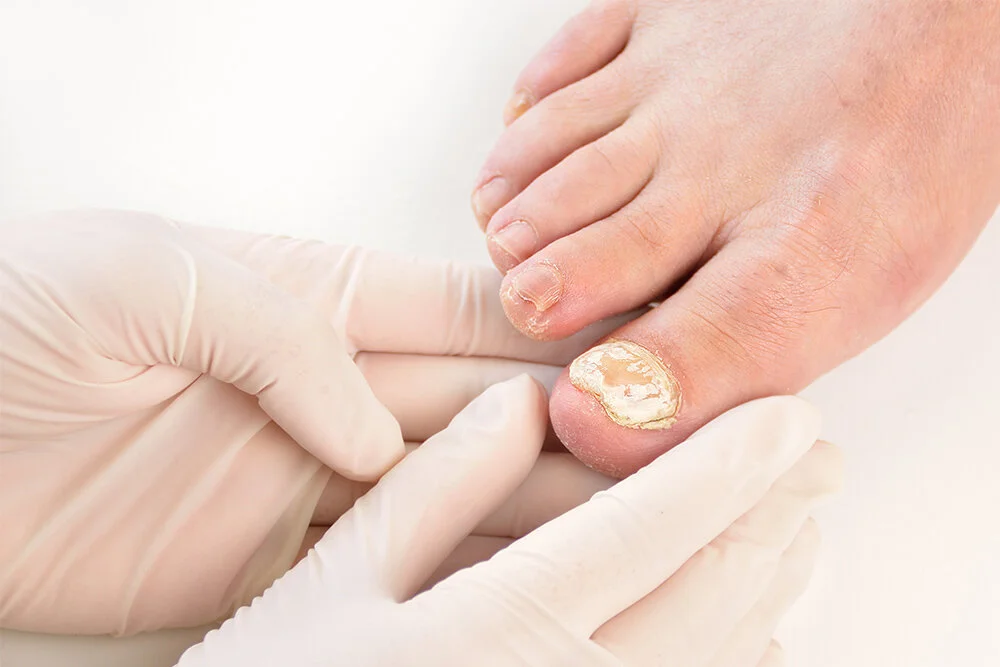Fungal Nail Infections
Fungal Nail infestations affect over 2.0 million Australians
Onychomycosis is the medical name for the condition known as Fungal Nail. Fungal nails appear to be thickened, discoloured and crumbly. The unsightly appearance may continue to worsen over time if not treated.
Whilst it may be socially embarrassing for some people, because of its aesthetic nature, fungal nail has a serious impact on the nail’s health and life. The longer it is present, the harder it is to eradicate and the more damage it may cause. This article discusses the symptoms, of Fungal Nail, the causes, treatment options and preventative measures.
What is Fungal Nail?
Fungi are microscopic organisms that don’t need sunlight to survive. Some fungi have beneficial uses but others cause illness and infection. Fungal Nail is caused by the same fungi that is responsible for jock itch, athlete's foot and ringworm.
The microscopic fungi invade the skin through cuts or fissures (e.g. cracked heels) that are so tiny that you may not even see them. The may invade through separations between the nail and the nail bed.
As fungi thrive in warm, moist environments, nails kept hidden away inside shoes or under synthetic nail polish, gels, shellacs and lacquers can be vulnerable to fungi, which then readily populate, hence - fungal infestation.
The infected nail becomes more severe as the fungi population exponentially grows.
Symptoms
• Thickened, brittle, crumbly or ragged nails.
• Distorted in shape.
• Becoming dull with the loss of shine.
• A dark discolouration gradually develops from debris building up under the nail.
• Eventually the nail may separate from the nail bed, a condition called onycholysis.
Levels of Severity vary depending on the length of time that the infection has been present and the conducive nature of the environment for fungi growth.
At My Family Podiatrist, we assess the severity of the infection using an Assessment Matrix, that measures the concentration of fungi, closeness of the infection to the nail matrix and coverage of the infection over the nail surface. From this diagnosis and information a Treatment Plan can be devised based on this data.
Treatment options today are more extensive, safe, natural, successful and time effective.
Treatment Options
• Topical Paints often have a poor success rate or require long periods of application and a patient disposition to see visible results.
• Prescription drugs which are harsh, invasive, and may have contra-indications.
• Laser, on the other hand, is effective but often more expensive
• PACT Photo Dynamic Therapy involves the interaction of light with a gel that is highly photosensitive, transmitting dynamic light that kills the infestation.
Why we recommend PACT Therapy
• It is medically researched for effectiveness and has the biggest impact on infection and the greatest success rate.
• It is far less costly that laser, more effective in clinic tests and is less time consuming. The therapy is safe, natural, cost-effective.
• It destroys virus and fungus without pain. Sufferers no longer need drugs, expensive lasers, or never-ending anti–fungal creams.
About PACT Therapy
Initially our Podiatrist will do a Fungal Nail Assessment and make a diagnoses on the severity of the condition, educate you on the condition and range of treatment options and answer your questions.
Together you will discuss the options leading to a decision as to which treatment best meets your needs and what preparation is needed. Photographs will be taken of your nails before treatment, after treatment and at the final check.
If PACT is the solution, then your nails will be trimmed and the surface will be debrided in preparation for the pre-treatment process.
At the next treatment a blue gel is applied to affected nails to encourage the maximum penetration of the light to follow. The blue gel is left on the nail for 10 minutes The PACT machine is then used on the nail. This takes 9.5 minutes to penetrate the nail.
The Assessment Matrix will indicate how many treatments you will need, which are usually undertaken one week apart.
After the completion of the treatments you will go about your life waiting for the new healthy portion of the nail to become visible. Patient waiting time may be the hardest part of the process, especially if your nails are not fast growing.
Take the first step!


